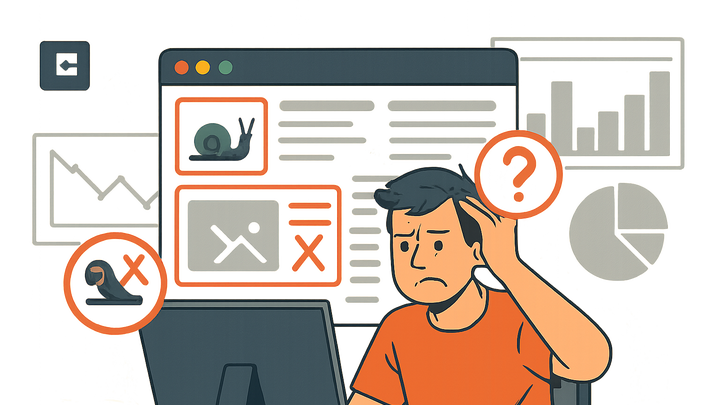Published on 2025-06-29T19:18:06Z
What Are Pain Points? Examples for CRO, UX, and SEO Critiques
Introduction
Pain points are the specific problems or frustrations that users encounter when interacting with a website. In the context of Conversion Rate Optimization (CRO), User Experience (UX), and Search Engine Optimization (SEO), identifying pain points is crucial to improving engagement, boosting conversions, and enhancing overall satisfaction. These friction points can range from confusing navigation, slow load times, poor mobile responsiveness, to unclear calls-to-action and inaccessible content. By systematically uncovering and addressing these issues, businesses can reduce bounce rates, improve user retention, and drive more qualified leads. Tools like Prevue.me automate this process by providing actionable critiques across CRO, lead generation, SEO, UX, and accessibility, helping teams prioritize fixes that deliver the highest impact.
Why Pain Points Matter
- They highlight critical barriers preventing users from achieving their goals.
- Resolving them leads to tangible improvements in conversion rates and search rankings.
- They inform design and content decisions grounded in real user needs.
With a clear map of pain points, organizations can allocate resources efficiently, deliver better experiences, and foster long-term customer loyalty.
Pain points
Pain points are the user frustrations and barriers on a website that hinder conversions, usability, and SEO success.
Understanding Pain Points
This section defines pain points in the context of website optimization and explains their significance across CRO, UX, and SEO disciplines.
-
Definition of pain points
Pain points are specific obstacles or sources of frustration that prevent visitors from completing desired actions on a website.
- User frustrations:
Emotions like confusion or annoyance experienced when a site fails to meet expectations.
- Business impacts:
Consequences such as lost revenue, decreased engagement, and poor search visibility.
- User frustrations:
-
Importance in website critiques
Recognizing pain points is the foundation of any effective CRO, UX, or SEO audit.
- Conversion barriers:
Elements that directly obstruct checkout processes or lead form submissions.
- Seo and ux overlaps:
Issues like slow page speed that harm both user satisfaction and search rankings.
- Conversion barriers:
Types of Pain Points in Website Optimization
Website pain points can be categorized to guide targeted improvements and resource allocation.
-
Functional issues
Bugs, broken links, and errors that prevent features from working correctly.
- Broken forms:
Contact or checkout forms that fail to submit or return errors.
- Javascript errors:
Console errors that disrupt interactive elements.
- Broken forms:
-
Usability issues
Design flaws and navigation challenges that confuse users.
- Poor navigation structure:
Menus or links that are hard to find or understand.
- Unclear ctas:
Buttons or prompts that don’t convey a clear next step.
- Poor navigation structure:
-
Performance bottlenecks
Slow load times and resource-heavy elements that degrade the user experience.
- Slow page load times:
Pages taking too long to render, often due to unoptimized assets.
- Unoptimized media:
High-resolution images and videos that increase bandwidth usage.
- Slow page load times:
-
Content and seo gaps
Missing, thin, or poorly optimized content that fails to meet user intent or rank well.
- Keyword cannibalization:
Multiple pages competing for the same keyword, diluting ranking potential.
- Thin content:
Pages with insufficient information to satisfy user queries.
- Keyword cannibalization:
-
Accessibility barriers
Issues that prevent users with disabilities from effectively using the site.
- Missing alt text:
Images without descriptive alternative text for screen readers.
- Insufficient contrast:
Text and background colors that make content hard to read.
- Missing alt text:
Identifying and Addressing Pain Points Using Prevue.me
prevue.me streamlines the detection and resolution of website pain points by offering automated and prioritized critiques.
-
Automated website analysis
Leverage prevue.me’s automated scans to uncover CRO, UX, SEO, and accessibility issues.
- Accessibility audit:
Reports on compliance with WCAG standards.
- Cro heuristic analysis:
Evaluations of form flows, CTAs, and funnel leaks.
- Seo health check:
Insights on page speed, metadata, and keyword usage.
- Ux evaluation:
Assessments of layout consistency and navigation ease.
- Accessibility audit:
-
Prioritizing pain points
Use impact vs. effort scoring in prevue.me to rank issues by business value and complexity.
- Impact vs. effort matrix:
Visual tool to focus on high-impact, low-effort fixes.
- User feedback weighting:
Incorporate actual user complaints and session replays into prioritization.
- Impact vs. effort matrix:
-
Implementing recommendations
Translate prevue.me’s critiques into actionable tasks for your development and design teams.
- Action plans:
Detailed step-by-step fixes for each identified issue.
- Team collaboration:
Assign tasks, set deadlines, and track progress within the prevue.me dashboard.
- Action plans:
-
Tracking improvements
Monitor the impact of changes over time to validate pain point resolutions.
- A/b tests:
Experiment with variations to measure conversion uplifts.
- Performance monitoring:
Use prevue.me’s reporting to track metrics like page speed and bounce rate.
- A/b tests:
